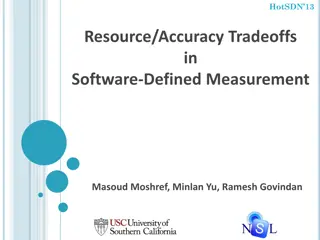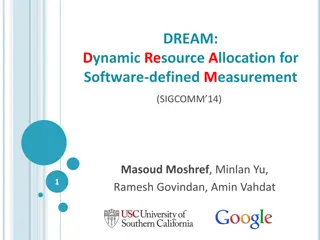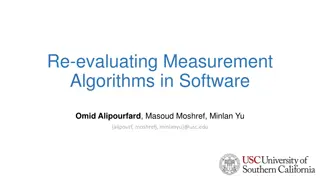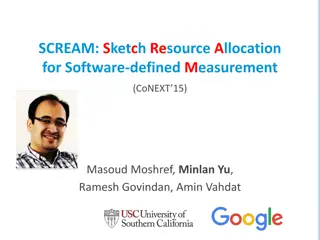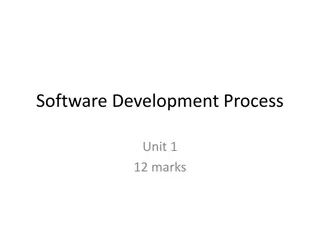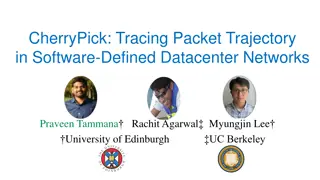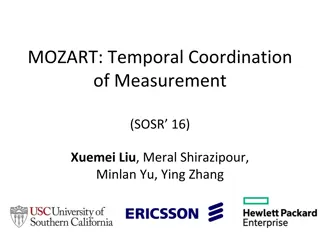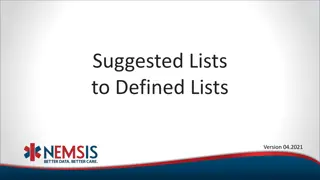Enhancing Network Measurement with Software-Defined Solutions
Management, measurement, and control in traffic engineering are crucial for identifying traffic patterns, understanding flow characteristics, and diagnosing performance issues. This article emphasizes the growing importance of measurement in modern networks, highlighting challenges faced and proposing software-defined solutions to enhance network-wide visibility and control.
- Network Measurement
- Traffic Engineering
- Software-Defined Networking
- Performance Diagnosis
- Control Functions
Download Presentation

Please find below an Image/Link to download the presentation.
The content on the website is provided AS IS for your information and personal use only. It may not be sold, licensed, or shared on other websites without obtaining consent from the author. Download presentation by click this link. If you encounter any issues during the download, it is possible that the publisher has removed the file from their server.
E N D
Presentation Transcript
OpenSketch Slides courtesy of Minlan Yu 1
Management = Measurement + Control Traffic engineering Identify large traffic aggregates, traffic changes Understand flow characteristics (flow size, delay, etc.) Performance diagnosis Why my application has high delay, low throughput? Accounting Count resource usage for tenants 2
Measurement is Increasingly Important Increasing network utilization in larger networks Hundreds of thousands of servers and switches Up to 100Gbps in data centers Google drives WAN links to 100% utilization Requires better measurement support Collect fine-grained flow information Timely report of traffic changes Automatic performance diagnosis 3
Yet, measurement is underexplored Vendors view measurement as a secondary citizen Control functions are optimized w/ many resources NetFlow/sFlow are too coarse-grained Operators rely on postmoterm analysis No control on what (not) to measure Infer missing information from massive data Network-wide view of traffic is especially difficult Data are collected at different times/places 4
Software-defined Measurement SDN offers unique opportunities for measurement Vendors build simple, reusable primitives Operators decide what to measure dynamically Operators regain network-wide view Controller Heavy Hitter detection Change detection 1 1 Configure resources (Re)Configure resources 2 Fetch statistics 5
Challenges Diverse measurement tasks Generic measurement primitives at switches Modularized measurement library in the controller Limited switch resources for measurement New data structures to reduce memory usage Multiplexing across many measurement tasks 6
Rethink Measurement Abstraction for SDN Controller Configure devices and collect measurements API to the data plane (OpenFlow) Fields action counters Src=1.2.3.4 drop, #packets, #bytes Switches Forward/measure packets 7
Tradeoff of Generality and Efficiency Generality Supporting a wide variety of measurement tasks Who s sending a lot to 23.43.0.0/16? Is someone being DDoS-ed? How many people downloaded files from 10.0.2.1? Efficiency Enabling high link speed (40 Gbps or larger) Ensuring low cost (Cheap switches with small memory) Easy to implement with commodity switch components 8
NetFlow: General, Not Efficient General Log sampled packets, or flow-level counters OK for many measurement tasks Not efficient for any single task It s hard to determine the right sampling rate Measurement accuracy depends on traffic distribution Turned off or not even available in datacenters 9
Streaming Algo: Efficient, Not General Efficient for individual task E.g. Who s sending a lot to host A? Count-Min Sketch: Data plane Control plane 3 0 5 1 9 Query: 23.43.12.1 Hash1 # bytes from 23.43.12.1 5 3 4 0 1 9 3 0 Hash2 Hash3 1 2 0 3 4 Pick min: 3 Not general Require customized hardware or network processors Hard to implement all solutions in one device 10
Today Sketches are Developed to Improve Precision Pro s Sketches are optimized algorithms Use minimal space Very accurate Con s Each Sketch require unique specialized hardware Sketches do not generalize Goal: General infrastructure that supports multiple sketches 11
Where is the Sweet Spot? General Efficient NetFlow/sFlow (too expensive) Streaming Algo (Not practical) OpenSketch General, and efficient data plane based on sketches Modularized control plane with automatic configuration 12
Flexible Measurement Data Plane Picking the packets to measure Classify flows with different resources/accuracy Filter out traffic for 23.43.0.0/16 Hashes to represent a compact set of flows Bloom filter for a set of blacklisting IPs Storing and exporting the data Diverse mappings between counters and flows E.g., More accuracy for elephant flows E.g., Volume counter vs distinct counters 13
Insights Measurement task can be viewed as SQL-ish queries Select count(*) from * where ip= <blah> group by <bah> Traffic-count: Select count(*) from * where dstip=10.10.20.3 group by SrcIP Select count(*) from * group by packet-content The group by: can be accomplished by a hash The where: can be accomplished by a classifier The count: by a count primitive 14
A three-stage pipeline Data Plane pkt. Classification Hashing Counting 3 0 5 1 9 Hash1 # bytes from 23.43.12.1 0 1 9 3 0 Hash2 Hash3 1 2 0 3 4 15
Build on Existing Switch Components A few simple hash functions 4-8 three-wise or five-wise independent hash functions Leverage traffic diversity to approx. truly random func. A few TCAM entries for classification Match on both packets and hash values Avoid matching on individual micro-flow entries Flexible counters in SRAM Logical tables with flexible indexing Access counters by addresses 16
Modularized Measurement Libarary A measurement library of sketches Bitmap, Bloom filter, Count-Min Sketch, etc. Easy to implement with the data plane pipeline Support diverse measurement tasks Implement Heavy Hitters with OpenSketch Who s sending a lot to 23.43.0.0/16? count-min sketch to count volume of flows reversible sketch to identify flows with heavy counts in the count-min sketch 17
Support Many Measurement Tasks Measurement Programs Building blocks Line of Code Heavy hitters Count-min sketch; Reversible sketch Config:10 Query: 20 Superspreaders Count-min sketch; Bitmap; Reversible sketch Count-min sketch; Reversible sketch Config:10 Query:: 14 Config:10 Query: 30 Traffic change detection Traffic entropy on port field Multi-resolution classifier; Count-min sketch Config:10 Query: 60 Flow size distribution multi-resolution classifier; hash table Config:10 Query: 109 18
Resource management Automatic configuration within a task Pick the right sketches for measurement tasks Based on provable resource-accuracy curves Resource allocation across tasks Operators simply specify relative importance of tasks Minimize weighted error using convex optimization Decompose to the optimization of individual tasks 19
OpenSketch Architecture Control Plane measurement program ... Heavy Hitters/SuperSpreaders/Flow Size Dist. measurement library CountMin Sketch Reversible Sketch SuperLogLog Sketch Bloom filter ... query report configure Data Plane pkt. Classification Hashing Counting
OpenSketch Conclusion OpenSketch: Bridging the gap between theory and practice Leveraging good properties of sketches Provable accuracy-memory tradeoff Making sketches easy to implement and use Generic support for different measurement tasks Easy to implement with commodity switch hardware Modularized library for easy programming 21



